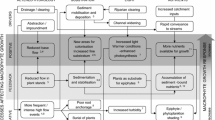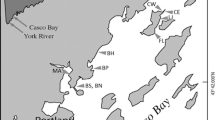Abstract
Macrophyte beds have been shown to influence organic matter retention and nutrient processing in streams. Less is known about the extent to which plant beds contribute to abundance, biomass, and diversity of macroinvertebrate assemblages in low-order streams. We measured aquatic invertebrate abundance, biomass, and diversity associated with plant beds and sand/gravel patches in a low-gradient second-order stream in the Central Sand Plains of Wisconsin, USA from March to October. Invertebrate abundance and biomass were higher on average in plant beds (2,552 m−2 and 1,575 mg m−2) than in sand/gravel patches (893 m−2 and 486 mg m−2). Although sand/gravel habitat was over three times more abundant than plant beds in the study reach, plant beds and sand/gravel patches contributed similarly to invertebrate abundance and biomass at the whole-reach scale. The abundance and biomass of invertebrates associated with plant beds decreased from spring to autumn. Non-insect invertebrates in the plant beds increased in relative abundance as the year progressed. Shannon–Weiner diversity and taxa richness of invertebrates were higher in the plant beds than in the sand/gravel habitat. Our results suggest that plant beds can represent hot spots for invertebrate abundance and production in low-gradient streams, and have implications for stream management and restoration in these types of ecosystems.


Similar content being viewed by others
References
Alexander, A. C., J. M. Culp, K. Liber & A. J. Cessna, 2007. Effects of insecticide exposure on feeding inhibition in mayflies and oligochaetes. Environmental Toxicology and Chemistry 26: 1726–1732.
Andrews, D. A. & G. W. Minshall, 1979. Distribution of benthic invertebrates in the lost streams of Idaho. American Midland Naturalist 102: 140–148.
Becerra-Munoz, S. & H. L. Schramm, 2007. On the influence of substrate morphology and surface area on phytofauna. Hydrobiologia 575: 117–128.
Beketov, M. A., 2008. Community structure of Ephemeroptera in Siberian streams. Entomological Science 11: 289–299.
Benedet, L., C. W. Finkl & W. M. Hartog, 2007. Processes controlling development of erosional hotspots on a beach nourishment project. Journal of Coastal Research 23: 33–48.
Benke, A. C., A. D. Huryn, L. A. Smock & J. B. Wallace, 1999. Length-mass relationships for freshwater macroinvertebrates with particular reference to the Southeastern United States. Journal of the North American Benthological Society 18: 308–343.
Cardinale, B. J. & M. A. Palmer, 2002. Disturbance moderates biodiversity-ecosystem relationships: Experimental evidence from caddisflies in stream mesocosms. Ecology 83: 1915–1927.
Chambers, P. A., E. E. Prepas, H. R. Hamilton & M. L. Bothwell, 1991. Current velocity and its effect on aquatic macrophytes in flowing waters. Ecological Applications 1: 249–257.
Chantha, S. C., L. Cloutier & A. Cattaneo, 2000. Epiphytic algae and invertebrates on aquatic mosses in a Quebec stream. Hydrobiologia 147: 143–160.
Cotton, J. A., G. Wharton & J. A. B. Bass, 2006. The effects of seasonal changes to in-stream vegetation cover on patterns of flow and accumulation of sediment. Geomorphology 77: 320–334.
Downes, B. J., P. S. Lake, E. S. G. Schreiber & A. Glaister, 1998. Habitat structure and regulation of local species diversity in a stony upland stream. Ecological Monographs 68: 237–257.
Forshay, K. J. 2007. The influence of macrophytes, disease, and restoration on freshwater ecosystems. Ph.D. Dissertation. University of Wisconsin Madison, Madison, WI.
Fritz, K. M., M. M. Gangloff & J. W. Femilla, 2004. Habitat modification by the stream macrophyte Justica americana and its effects on biota. Oceologia 140: 338–397.
Gorman, O. T. & J. R. Karr, 1978. Habitat structure and stream fish communities. Ecology 59: 507–515.
Grubaugh, J. W., J. B. Wallace & E. S. Houston, 1997. Production of benthic invertebrate communities along a southern Appalachian river continuum. Freshwater Biology 37: 581–586.
Heck, K. L., Jr. & L. B. Crowder, 1991. Habitat structure and predator-prey interactions in vegetated aquatic systems. In Bell, S. S., E. D. Mcoy & H. R. Mushinsky (eds.), Habitat structure: the physical arrangement of objects in space. Chapman and Hall, New York: 281–289.
Hunter, C. J., 1991. Better trout habitat: a guide to stream restoration and management. Island Press Publishing, Washington, DC.
Huryn, A. D. & J. B. Wallace, 2000. Life history and production of stream insects. Annual Review of Entomology 45: 83–110.
Hutchens, J. J., Jr., J. B. Wallace & E. D. Romaniszyn, 2004. Role of Podostemum ceratophyllum Michx. in structuring macroinvertebrate assemblages in a southern Appalachian river. Journal of the North American Benthological Society 23: 712–727.
Kaenel, B. R., C. D. Matthei & U. Uehlinger, 1998. Disturbance by aquatic plant management in streams: effects on benthic invertebrates. Regulated Rivers: Research and Management 14: 341–356.
Koetsier, P. & J. V. McArthur, 2000. Organic matter retention by macrophyte beds in two southeastern USA, low-gradient, headwater streams. Journal of the North American Benthological Society 19: 633–647.
Kohn, D. D. & D. M. Walsh, 1994. Plant species richness—the effect of island size and habitat diversity. The Journal of Ecology 82: 367–377.
Krueger, C. C. & M. C. Waters, 1983. Annual production of macroinvertebrates in three streams of different water quality. Ecology 64: 840–850.
Lester, R. E., W. Wright & M. Jones-Lennon, 2007. Does adding wood to agricultural streams enhance biodiversity? An experimental approach. Marine and Freshwater Research 58: 687–689.
Leuven, R. S. E., T. C. M. Brock & H. A. M. van Druten, 1985. Effects of preservation on dry- and ash-free dry weight biomass of some common aquatic macro-invertebrates. Hydrobiologia 127: 151–159.
Maltchik, L. & F. Pedro, 2001. Responses of aquatic macrophytes to disturbance by flash floods in a Brazilian semiarid intermittent stream. Biotropica 33: 566–572.
Merritt, R. W. & K. W. Cummins, 1996. An introduction to the aquatic insects of North America. Kendall/Hunt publishing company, Dubuque, IA.
Muokta, T., R. Paavola, A. Haapala, M. Novlkmec & P. Laasonen, 2002. Long-term recovery of stream habitat structure and benthic invertebrate communities from in-stream restoration. Biological Conservation 105: 243–353.
Myers, N., 1988. Threatened biotas: “hot-spots” in tropical forests. The Environmentalist 8: 187–208.
Negishi, J. N. & J. S. Richardson, 2003. Responses of organic matter and macro-invertebrates to placements of boulder clusters in a small stream of south-western British Columbia, Canada. Canadian Journal of Fisheries and Aquatic Sciences 60: 247–258.
Payne, L. X. & J. W. Moore, 2006. Mobile scavengers create hotspots of freshwater productivity. Oikos 115: 69–80.
Pearson, W. D. & D. R. Franklin, 1968. Some factors affecting drift rates of Baetis and Simulidae in a large river. Ecology 49: 75–81.
Phillips, E. C., 2003. Habitat preference of aquatic macroinvertebrates in an east Texas sandy stream. Oikos 18: 1–11.
Richardson, K., T. G. Nielson, F. B. Pederson, J. P. Heilman, B. Loekkegaard & H. Kaas, 1998. Spatial heterogeneity in the structure of the planktonic food web in the North Sea. Marine Ecology Progress Series 168: 197–211.
Riis, T. & B. J. F. Biggs, 2003. Hydrologic and hydraulic control of macrophytes in streams. Limnology and Oceanography 48: 1488–1497.
Sand-Jensen, K. & R. Mebus, 1996. Fine-scale patterns of water velocity within macrophyte patches in streams. Oikos 76: 169–180.
Shupryt, M. P. 2008. Are plant beds in streams hot spots of macroinvertebrate diversity, abundance and biomass? Unpublished master’s thesis, University of Wisconsin-Oshkosh, Oshkosh, WI, USA.
Smock, L. A., 1987. Life histories, abundance and distribution of some macroinvertebrates from a South Carolina, USA coastal plain stream. Hydrobiologia 157: 193–208.
Taniguchi, H., S. Nakano & M. Tokeshi, 2003. Influences of habitat complexity on the diversity and abundance of epiphytic invertebrates on plants. Freshwater Biology 48: 718–728.
Thorp, J. H. & A. P. Covich, 2001. Ecology and classification of North American freshwater invertebrates. Academic Press, San Diego, CA.
Thorp, A. G., R. C. Jones & D. P. Kelso, 1997. A comparison of water-column macroinvertebrate communities in beds of differing submersed aquatic vegetation in the tidal freshwater Potomac River. Estuaries 20: 86–95.
Warfe, D. M. & L. A. Barmuta, 2006. Habitat complexity mediates food web dynamics in a freshwater macrophyte community. Oceologia 150: 141–154.
Wharton, G., J. A. Cotton, R. S. Wotton, J. A. B. Bass, C. M. Heppell, M. Trimmer, I. A. Sanders & L. L. Warren, 2006. Macrophytes and suspension-feeding invertebrates modify flows and fine sediments in the Frome and Piddle catchments. Journal of Hydrology 330: 171–184.
Acknowledgments
This project was generously funded through a University of Wisconsin-Oshkosh Collaborative Grant and by the Central Wisconsin Chapter of Trout Unlimited through the Bill Beck Memorial Scholarship. We thank two anonymous reviewers for many helpful comments.
Author information
Authors and Affiliations
Corresponding author
Additional information
Handling editor: S. I. Dodson
Rights and permissions
About this article
Cite this article
Shupryt, M.P., Stelzer, R.S. Macrophyte beds contribute disproportionately to benthic invertebrate abundance and biomass in a sand plains stream. Hydrobiologia 632, 329–339 (2009). https://doi.org/10.1007/s10750-009-9856-z
Received:
Revised:
Accepted:
Published:
Issue Date:
DOI: https://doi.org/10.1007/s10750-009-9856-z




